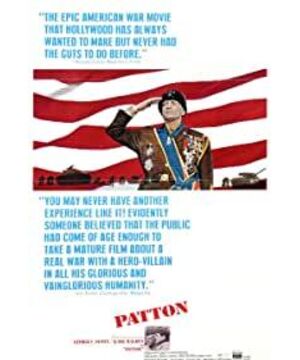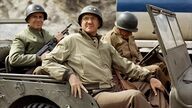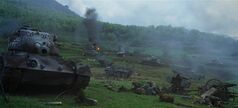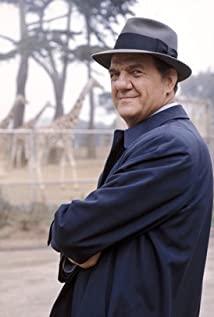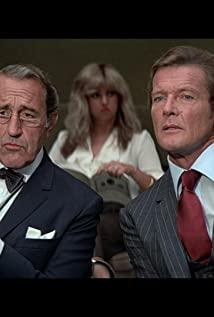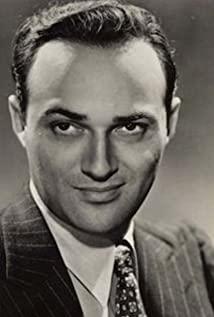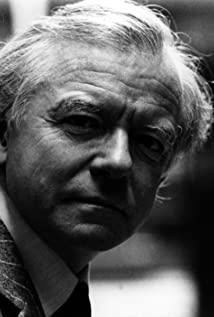In the first fifteen seconds of "Barton", the picture shows an American flag as soon as it comes out, and its four sides cannot be seen. In jargon, the audience only knows that this flag occupies the entire picture. As for how big it is, it is impossible to estimate. , Because there is only one flag on the screen and no other references. At the same time, we heard noisy human voices, followed by a "stand at attention" command and the sound of touching the heel of shoes. Of course we know that the noisy voice is the troop. Then a small figure emerged from the lower border in the middle of the frame, rather, it rose up. This kind of picture processing, due to the unusual proportions of the frame of reference (Barton’s figure is so small) and the changes in the depth relationship (Barton appears in front of the national flag, so the Stars and Stripes retreat in the audience’s mind), so it is in the minds of the audience. The flag here suddenly became bigger, and the three-dimensional illusion was strengthened. The effect is probably that the flag is so big! In this way, the film makers first connected the United States and the United States in just fifteen seconds from the beginning of the film through visual illusion effects. The subject came out. This is the most high-end political propaganda. It is so wonderful that it uses the natural reaction of the audience's psychology caused by the audio-visual language composed of light waves and sound waves. You are anti-imperialist, but when you look at this lens, the flag still gets bigger. You can say that the United States is not great, but Patton said, I did not say that the United States is great, I only came to the stage to give a speech to my soldiers, what are you holding up? Because the audio-visual language of the movie is imitating the experience of human audio-visual perception, if its screen image is correct, the changes like this flag will be irresistible.
Then Button took four steps forward, stood still, saluted, and sounded the flag-raising bugle of the US Army. The filmmakers used the time of raising the flag and used more than a dozen shots to shape the visual image of Patton through visual language: the masculine uniform, including breeches, riding boots and steel helmet, white eyebrows, dazzling array of medals, wedding rings, the Catholic Pope The ring presented was a horse whip symbolizing military discipline, an ivory pistol, the military emblem of the US Armored Third Army, piercing eyes, and a four-star general (note: it was actually only after the surrender of Germany that Congress promoted him to four stars. Will be). From then on, a minute and a half ago, the audience had received a lot of impressive information, but there was no word or language.
At the end of the flag-raising ceremony, Patton said "sit down" and we heard the sound of people sitting down. Please note that in the six and a half minutes of the opening, we only saw Button and the sound of the soldiers listening to the speech, but did not see the other person. Why, discuss it below.
Button began to speak. The content is to boast that Americans can fight and never lose. I think the most thoughtful military philosophy is his first sentence: "No stupid bastard wins a war by sacrificing for his country. He let the other bastard sacrifice for his country and win the war. This is very insightful. One sentence. Some people win the war by relying on the dead to die. There is no need to say more about the precepts. We noticed that when Patton was speaking on the stage, he was walking back and forth, the camera position slowly moved forward, and the scene was different. When he said the last sentence at the end of the speech, it became the biggest close-up in this paragraph, and then he turned and stepped off the stage and ended, and the music started. This is a very beautiful rhythmic structure. At the same time, his up and down movements take four steps forward, and Move left and right on the stage to form a three-dimensional movement of length, width and height, showing a three-dimensional space, which is exactly the trick of Hollywood movies. People live in three-dimensional space, so people are used to seeing three-dimensional space. .
Let’s take a closer look at how this passage was shot and why it was shot like this. (I remind readers that the important thing is not what subject matter, but how to shoot. Lei Feng’s story can be shot by anyone, but different people shot it. The result is different.)
We noticed that when Patton was walking around on the stage in the mid-range, he at most walked on the bottom line of the frame, so the podium was not exposed. In addition, when Patton's speech was about to end, he turned and looked back at the last words spoken by the camera lens (that is, the audience). I am willing to lead any of you to it at any time, on any battlefield. fighting. It should be noted that one of the conventions of Hollywood movies is that the eyes of the characters on the screen cannot look at the audience. Because when the character looks at the audience, the two visions intersect, and this lens becomes the subjective lens of the audience (this is the subjective lens), and this line of sight connects the world (space) on the screen with the real world the audience is in. (Space) are connected together so that the audience will compare these two spaces, so the illusion of the world on the screen disappears, and the Hollywood Dream Factory goes bankrupt. But the director of this film wanted Button to squint at the camera for a long time. What role does this play? I later asked many students in class: "Who is Patton looking at?" Most of them think deeply from the comprehensive art theory, what he is thinking about, he stares at the sky, he looks at the soldiers, and looks at the audience. But no one said his simplest and most direct feeling: he looked at me. Those audiences who didn't understand the movie at all said without thinking, he looked at me. correct. This is feeling. Every audience felt Patton’s eyes staring at himself and said, I am willing to lead any of you to fight at any time, on any battlefield. Are you going? Button is recruiting troops. Scott's Patton's personal charm is even more vividly displayed in the opening scene.
Then we put together all the factors mentioned above, we can clearly see the intention of the creator. The group of people implied by the sound of the space outside the painting never showed up, and the fixed position of the camera is the point of view of the audience. The photographer pays particular attention to not letting the stage appear in the picture. Patton mostly stepped on the bottom line of the frame, which is the point of view of an audience who is listening attentively. Then Patton finally looked at the camera, so that the audience clearly felt that they were occupying the space under the podium, which forced the audience to identify with the audience in the film, that is, the audience was listening to Patton's speech with them.
In the first six and a half minutes of the film, Patton took the stage to deliver an agitating speech to the soldiers, which fully revealed the film's intentions: to promote and agitate young audiences. This intention is implemented throughout the prologue, and is reflected in the processing of the audiovisual factors of each shot.
Now we clearly see that it would be a big mistake to treat this scene as a speech like many Chinese film critics. For a film review, any film theory should be based on the lens, not a literary review or dramatic empty-head theory. Why do literary reviews not mention the attributes of movies, and why do drama reviews do not mention the time and space of movies. Is it just bullying that the movie is young? Young people are not allowed to study from their own nature, but must study problems from the perspective of eDonkey? There is no literary or dramatic basis in this film, and literary or dramatic reviews cannot make the above analysis. Some critics focused on analyzing the content of Barton's speech when analyzing this paragraph, which is really off the topic. That is due to the lack of audiovisual and reading ability. This is a very superb militaristic psychological warfare, which makes full use of the power of the language of the film, and Scot's acting skills also make many audiences forget the essence of his speech.
So why does the director handle the opening of the film this way?
Let's study the social situation of the entire United States when the film came out (1970).
Do the audiences who have watched "Barton" feel that this is a propaganda film that promotes the military spirit of American imperialism? It seems that some people think that this film is an anti-military film. Our socialist CCTV broadcasted "Barton" more than five times, which is simply inexplicable. It is the biggest mistake caused by not understanding the audiovisual language. Don't we know that some young people who watched our documentary film introducing the United States said that they really wanted to go to that dire place. What's the use of your distressed commentary? The picture reported them.
Others think this is a patriotic film. The lovely country is specific, and we cannot educate our people with their patriotic films of Japan during World War II. Because the audiovisual image of the movie is so specific, some people may love Japan, America, and Barton. We cannot judge a film based on our own likes and dislikes, or the declaration of the creator. For the evaluation of any work of art, we must first fully consider the background of the work and the form of expression of the work. As far as a film is concerned, its form of expression must be shots, not literary. You know, Hollywood movies have always used visual images to tell stories, and they have never violated the domestic and foreign policies of the US government. Also, Hollywood movies are business, and catering to the audience is its top priority. It has always been based on the box office, and it has to meet the audience's interest and social thoughts at that time. Think of Hollywood filmmakers (they call themselves filmmakers, filmmakers, not creators, which makes sense) as artists, and regard their works as creators expressing their personal opinions and being unique. The style of work of art is wrong, it demeans oneself. Imagine that some people actually regard entertainment films as art films. For example, they regard "Escape from the Tiger's Mouth" as a boutique. It is
conceivable that the level of its people is low.
Let us now study the American social background from the late 1960s to the early 1970s. American historians call this period the dark era in American history, an era of disintegration. Following the Cold War and militarism, Kennedy, Martin. Luther King and other political assassinations and the Watergate incident have shaken Americans' faith in the American system of government. The human rights movement brought about a rebellion of blacks and students. After the black human rights movement opposed the demand for apartheid, it put forward the slogan calling for apartheid, namely black power, and in 1967 it developed to cities such as Detroit, Chicago, and even the capital, Washington, where blacks took guns. On the street, there was a gun battle with the police. On the other hand, college students suspended classes to cause revolution, rebelled on campus, and the government dispatched military police to suppress them. Four college students were killed before and after, causing an uproar in the society. In addition, the failure of the war of aggression against Vietnam was a foregone conclusion in 1970, the first indisputable failure of the United States. Young Americans refused to perform military service and burned their military service certificates in public. Boxing champion Ali was sentenced to jail for his refusal to perform military service at that time. This is the first complete failure in US military history, and even the war genre film that has always ended with the victory of the US army as a reunion has also gone bankrupt. Facing the reality of the defeat in the Vietnam War, the war genre film no longer exists. The only "Green Beret" filmed in 1968 to promote the Vietnam War, although it is still played by John. Wayne (J. Wayne) starred, but still suffered box office failure and critics criticized, the critics called it the final demise of the war film.
"Barton" came out under this special historical condition. Please don’t forget that, in the same situation, the Hollywood movie "Guess Who Will Eat Dinner" that was released in the first American Film Week held in our country was also shot in this era (1967), and its content is The black regime was against the slogan of the black liberation movement in the anti-government human rights movement at that time. That is to say, when the black liberation movement put forward the slogan of apartheid, this film said we were married. The Chinese subtitles were played in Hong Kong, and the subtitles deliberately cancelled the two mentions of denying the black regime in the dialogue of the film. We open our mouths and stick to the ideology of the proletariat, but in fact we are propagating works that oppose our ideology.
At first glance, this film about the legendary heroes who are well-known in the Second World War seems to be outside the social politics of the time, so it is more like a biographical film about a real historical figure. So people often overlook that it is a Hollywood film first, a Hollywood film shot in 1970. This kind of neglect will inevitably lead to people's wrong value judgments on the film, and this is exactly what Hollywood hopes to happen, just because any naked preaching will inevitably arouse the audience's resentment, and thus cannot achieve its true propaganda purpose. Hollywood is very good at this. There is a famous saying in Hollywood, "Do you preach? Rent an auditorium." So behind the guise of Barton, a real historical figure, is a Barton who is soaked in the full set of Hollywood value systems and relies on Hollywood mythology. This myth is hero worship.
The theme of the film is the American martial spirit. Although the U.S. government does not have a propaganda agency in charge of ideology to formulate propaganda policies for literary and artistic works, the Hollywood film industry, which is based on business and therefore based on the social collective cultural concept, never violates the internal and external policies of the U.S. government. policy. In addition, Hollywood has a group of audiences who like to watch war films and worship individual heroism, and satisfying the requirements of these audiences is one of its financial resources. Therefore, it chose the life of the war hero General Patton in the eyes of the American people in the anti-fascist war to arouse the war adventure spirit of American youth. In this way, the subject matter of Patton's biography not only avoids the controversial and intractable and sensitive subject of the Vietnam War, but also has a strong anti-communist color. You know, no matter what differences exist between socialist countries, for Americans, communism is communism. What's more, in the early 1970s, the Cold War was not over yet (not long after the Cuban missile incident), these issues still have great appeal to American audiences.
Patton is a hero in the eyes of the Americans. As early as during the First World War, the tank brigade he led was in Saint Petersburg. Mikhail made military exploits during the Battle of Mikhail, and he himself was awarded the British Service Meritorious Cross. During the Second World War, he led the first American troops to land in North Africa. Afterwards, his Third Army was another main force with many achievements on the second battlefield, especially in Bastogne’s rescue of the 101st division and the beating of soldiers suffering from artillery shock, which made him a worldwide leader. A legendary character, even middle school students in the eastern countryside who have experienced World War II like me know Patton. He is considered by most to be the only commander in the United States who can fight tough battles.
This mythical figure described by the Hollywood director can be said to be an American-style three prominent figure. Those with strong film reading skills will find that most of the shots for Patton are slightly high. The director not only deliberately used his British rival Montgomery to play an actor who is shorter than Patton, but also when the two of them are in the same position. When in the lens, the camera position framing intentionally caused Button to be a head higher than Montgomery, which is particularly obvious in the passage where Massey was included in the city. There is also a handwriting that violates the rules of life, that is, Button hitting a plane. When German Hengel swooped down and fired, Patton opened his legs and aimed the plane with a pistol and fired, and the impact point of the German aircraft machine gun extended from a distance to the back between Patton's legs. Not split in half by bullets? It is invulnerable, but in the continuous short shots, the audience is not easy to notice. Only aroused admiration. After Button hit the soldiers, Eisenhower asked him to go to the army for inspection. He prayed in the church before doing the review. The camera took a low position. Button kneeled in front of the altar. God is up and Button down. This is in line with their religious beliefs, but the low camera position is set very cleverly. When Button is kneeling there, the low camera is The camera is level with him, but when Patton stands up, the camera shakes up and naturally forms a big shot of Patton. Take a big shot before the review? The director's POV (that is, point of view attitude) is already very clear. Don't forget, the attitude of the creator will be determined as soon as the camera is placed. Why do you put the camera here and not there, you have your thoughts, and you have your attitude towards the events in the lens. When he walked out of the church and was walking in the courtyard of the palace, the director finally used a big overhead shot, and it was the largest overhead shot in the film. I think its position in the rhythm curve of the entire film structure is extremely accurate. It echoes the darkest facial shot of Barton (the darkest light) in the next paragraph on the rhythm curve, which is in line with the development of the plot. However, the framing of this lens is exceptionally subject to the static painting composition. Very strict. There is an even court on both sides, and the foreground is a projection of the court. On the upper side of the screen, there are two tanks parked diagonally, one on the left and the other on the right. Button's tiny figure moved slowly from the center. Very majestic and solemn. Although it is the biggest overhead shot, it is not derogatory. When he walked to the review platform, the camera on the elevator started from being flat, swaying to the right while rising, and finally turned into a big overhead shot. But when Patton spoke, the camera immediately jumped under the platform to shoot Patton upside down. The sun was behind him, almost forming a halo. The director found the basis for the up-shooting, because Patton’s first sentence was, “You know someone wants me to come here to show you that I’m a Son of a bitch. "This sentence caused laughter in the audience. Patton won, and the atmosphere of the review was completely destroyed by this sentence. The camera stayed there and kept shooting up until Patton's review said, "I admit I The method is wrong.” When the word error appears, the camera cuts to the big overhead shot taken from behind Button. But after the two characters, I immediately return to the original upside-down position. Then wait until the second Button. Then he said, "I hope you will accept my explanation and-(the camera is cut to the top) apologize. "
The camera cut back immediately, and Patton turned around and said "disband". This paragraph is very interesting, the director's POV is too obvious. He is so reluctant to leave to take the shot, so he is reluctant to demean Patton. These are three outstanding examples of the mythical figure of Patton.
Supplementary date: 2005-07-03 14:41:45
: [ Repost ] Take a look at the video analysis class of the synthesizer!
Su Mu's "Film Analysis" teaching plan
.
As a film analysis, the first thing that should be discussed is film time and space. It is a relative relationship. Specifically, we have to study how the creator of a certain film handles the temporal and spatial relationship of his film.
Then it is light waves and sound waves that reflect the time and space of the movie. In a system, there is no relationship between main and auxiliary, and light and sound are first used to shape the space of the movie. That is the space where you can see and hear.
How big is the movie space? Infinite, infinite space, is there any composition? No. The composition is a limited space concept, a closed space concept. What makes the time of a movie, or light and sound. Light and sound can also affect the audience's perception of movie time. So the time of the movie is relative.
Suffice it to say that this is the most basic thing formed by a film. Even if the integrative art critic does not recognize the time-space relationship of the film, there is still the time-space relationship in his film, but because the director did not recognize it, it was used. very bad.
For example, the most important thing for a man and a woman is the director's handling of film time and space. At the beginning, the director used the outside space twice, which is the concept of infinite space. We first clarify the director's concept of time and space through these two passages.
This is also the problem in the French lieutenant’s women, and like "A Man and a Woman", it shows the director's concept of time and space from the beginning. First at the shooting scene, the makeup artist tidyed up the actors and then played the board. The camera avoided the shooting scene and entered the time and space it was shooting. The camera follows the characters in the virtual story space, and it takes the audience to the time and space of the story unknowingly.
To grasp the main thing, there are too many trivial things in a movie, and you can talk about it for a long time if you grab one, but that is not a movie analysis class.
Su Mu obviously has no concept of relative time and space, and no system concept. In other words, he does not yet possess Einstein's theory of relativity, which all intellectuals in the 20th century should master, and as early as the 18th century, since the introduction of chemistry, people's understanding of the world is knowledge about relationships. That is the system. Water is a compound formed by the system of dihydrogen-oxygen. There is no such thing as hydrogen and heavy oxygen, because this is a chemical combination, not a physical mechanical addition, there are more or less problems.
Supplement date: 2005-07-03 14:42:43 It
is too easy to make detours in the harsh environment of this movie in China. You don't feel it because you are in it. But I know from your words how you have been affected. This is because my decades of experience are too rich.
Homework is the best way to counteract that bad influence.
Do you know why I don't allow you to think about content? First, form is more important than content. Because the function of form is to attract attention. If your work is no matter how deep it is, but the form fails to attract the attention of the audience, that is to say, if no one is watching, then what is the use of your so profound content. Second, the film uses audiovisual language. You have not yet formed a habit on this point. Your thinking is still within the scope of words and language. It will not help you to learn movies. I need to train you to learn audiovisual thinking first, and then you can think about problems from the perspective of the characteristics of the medium you use, first select materials and create creations.
Don't worry, if you are really anxious, then finish my assignments quickly and quickly. I demand the amount. Quality is the future.
View more about Patton reviews


